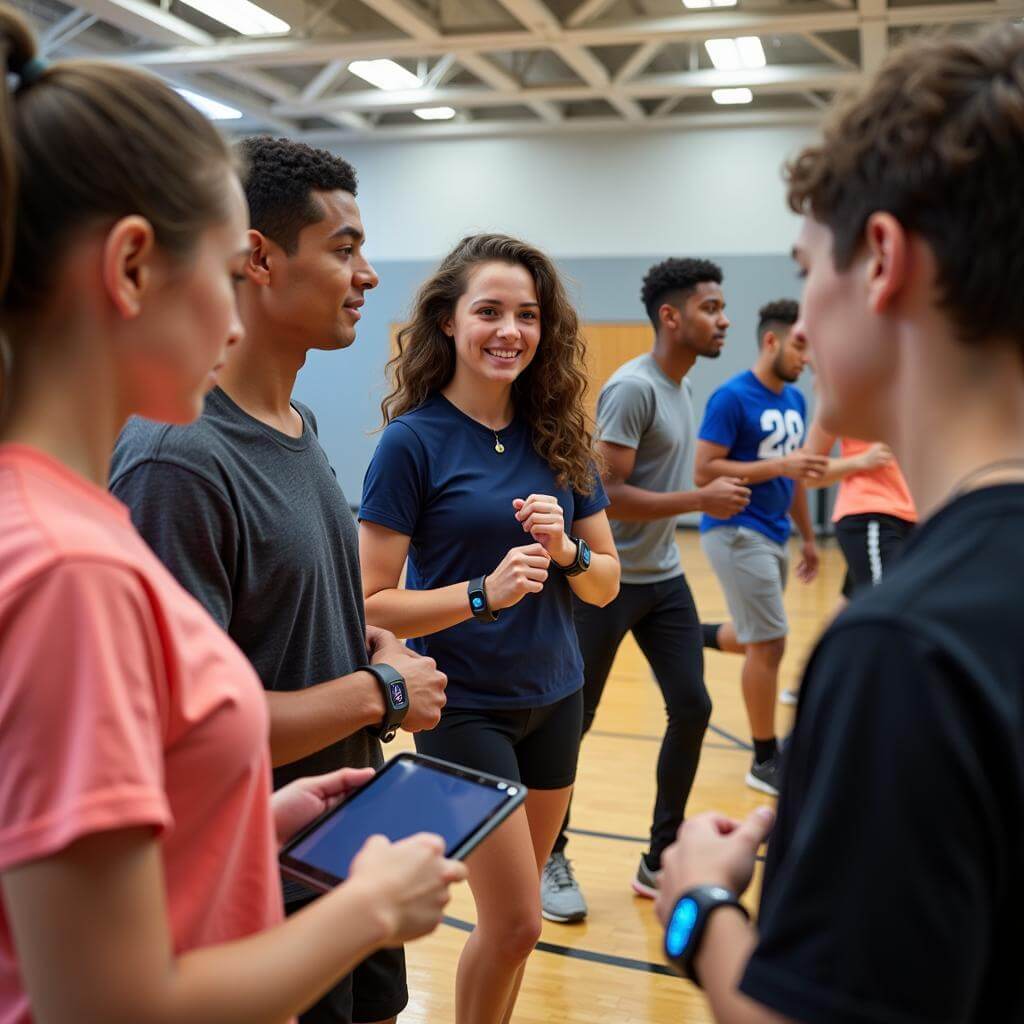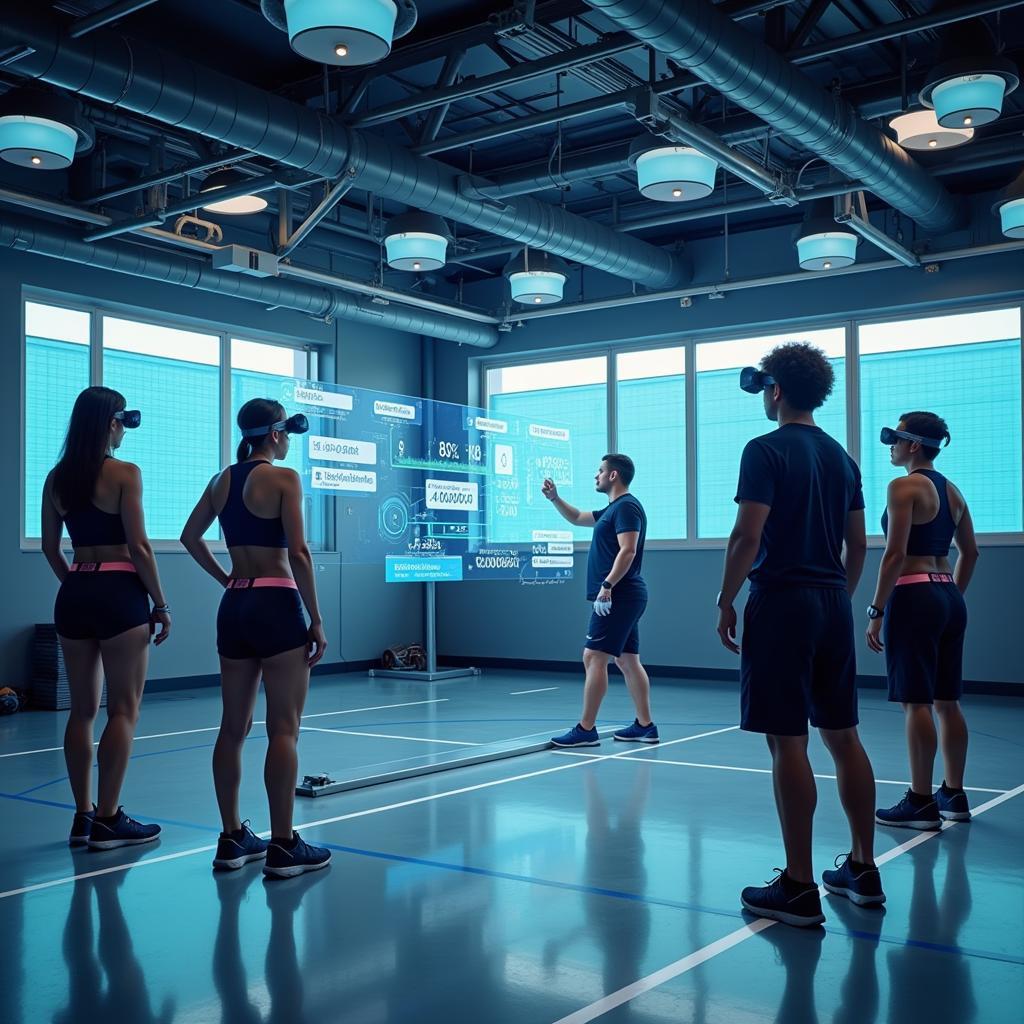In today’s IELTS Reading practice, we’ll explore how wearable technology is influencing physical education. This topic combines elements of technology, health, and education, making it an excellent subject for IELTS Reading comprehension. Let’s dive into our practice passages and questions.
Nội dung bài viết
Passage 1 – Easy Text
Wearable technology has revolutionized many aspects of our lives, including physical education. These devices, ranging from smartwatches to fitness trackers, are changing the way students and teachers approach physical education classes. They provide real-time data on physical activity, heart rate, and even sleep patterns, allowing for more personalized and effective fitness programs.
In schools across the globe, physical education teachers are incorporating wearable devices into their curriculum. Students can now track their progress over time, set personal fitness goals, and compete with classmates in a fun, engaging manner. This gamification of exercise has proven to be particularly motivating for young learners, encouraging them to be more active both in and out of school hours.
Moreover, wearable technology is helping to make physical education more inclusive. Students with different abilities can now participate more fully in PE classes, as these devices can be adjusted to suit individual needs and capabilities. This tailored approach ensures that every student can benefit from physical education, regardless of their initial fitness level or physical limitations.
 Students using wearable technology in PE class
Students using wearable technology in PE class
Questions 1-5: Multiple Choice
Choose the correct letter, A, B, C, or D.
-
According to the passage, wearable technology in physical education provides:
A) Only heart rate data
B) Real-time data on various health metrics
C) Information about students’ academic performance
D) Data on teachers’ performance -
The term “gamification” in the context of the passage refers to:
A) Playing video games in PE class
B) Making exercise more competitive and fun
C) Using game consoles for fitness
D) Teaching students about game design -
How does wearable technology make physical education more inclusive?
A) By eliminating the need for physical activity
B) By allowing only fit students to participate
C) By adapting to individual needs and abilities
D) By focusing solely on team sports -
Which of the following is NOT mentioned as a benefit of using wearable technology in PE?
A) Tracking progress over time
B) Setting personal fitness goals
C) Improving academic grades
D) Competing with classmates -
The passage suggests that wearable technology in PE is:
A) Only useful for a select few students
B) A temporary trend that will soon pass
C) Beneficial for students of all fitness levels
D) A replacement for traditional PE teachers
Answers:
- B
- B
- C
- C
- C
Passage 2 – Medium Text
The integration of wearable technology into physical education curricula represents a paradigm shift in how we approach fitness and health education in schools. This technological revolution is not merely about introducing gadgets into the classroom; it’s about fundamentally altering the way we perceive, measure, and promote physical wellness among students.
One of the most significant advantages of wearable technology in PE is its ability to provide objective, quantifiable data. Traditional methods of assessing physical fitness often relied on subjective observations or infrequent standardized tests. With wearable devices, educators can now access a wealth of data points, including steps taken, calories burned, heart rate variability, and even metrics related to sleep quality. This comprehensive approach allows for a more holistic view of a student’s health and fitness, extending beyond the confines of the gym class.
However, the implementation of wearable technology in PE is not without its challenges. Privacy concerns are at the forefront, as these devices collect sensitive health data from minors. Schools must navigate the complex landscape of data protection regulations and ethical considerations to ensure that students’ information is safeguarded. Additionally, there’s the issue of digital equity. Not all students have equal access to these devices, potentially creating a divide between those who can afford personal wearables and those who cannot.
How wearable technology is changing healthcare provides insights into the broader impact of these devices on health monitoring and management.
Despite these challenges, the potential benefits of wearable technology in PE are substantial. By providing real-time feedback, these devices enable students to take ownership of their fitness journey. They can set personalized goals, track their progress, and make informed decisions about their health. This level of engagement fosters a sense of autonomy and self-efficacy, crucial factors in developing lifelong healthy habits.
Moreover, wearable technology facilitates a more individualized approach to physical education. Teachers can use the data collected to tailor activities and interventions to each student’s needs and abilities. This personalization ensures that students are neither under-challenged nor overwhelmed, promoting optimal learning and development.
The future of wearable technology in PE looks promising, with emerging technologies like augmented reality (AR) and virtual reality (VR) poised to further revolutionize the field. These immersive technologies could potentially transport students to virtual environments where they can engage in a wide range of physical activities, from scaling virtual mountains to participating in simulated Olympic events.
 Teacher analyzing student fitness data
Teacher analyzing student fitness data
Questions 6-10: Identifying Information
Do the following statements agree with the information given in the passage? Write
TRUE if the statement agrees with the information
FALSE if the statement contradicts the information
NOT GIVEN if there is no information on this
- Wearable technology provides more objective data than traditional fitness assessment methods.
- All schools have successfully implemented wearable technology in their PE programs without any issues.
- The use of wearable technology in PE can help students develop a sense of autonomy.
- Augmented reality is currently widely used in PE classes across most schools.
- Wearable technology can help teachers personalize physical activities for individual students.
Questions 11-13: Sentence Completion
Complete the sentences below. Choose NO MORE THAN TWO WORDS from the passage for each answer.
- One of the challenges of implementing wearable technology in schools is ensuring students’ __ is protected.
- The issue of __ __ arises when not all students have equal access to wearable devices.
- Wearable technology allows students to receive __ __ on their performance during PE activities.
Answers:
- TRUE
- FALSE
- TRUE
- NOT GIVEN
- TRUE
- privacy
- digital equity
- real-time feedback
Passage 3 – Hard Text
The advent of wearable technology in physical education has catalyzed a seismic shift in pedagogical approaches, necessitating a reevaluation of traditional methodologies and the very essence of what constitutes effective health and fitness education. This technological integration transcends mere novelty, embodying a fundamental restructuring of how physical wellness is conceptualized, quantified, and cultivated within educational frameworks.
The implementation of wearable devices in PE curricula has engendered a paradigm of data-driven decision making that was hitherto unprecedented in the realm of physical education. These sophisticated devices, equipped with an array of sensors and analytical capabilities, provide educators with a cornucopia of biometric data, including but not limited to heart rate variability, respiratory patterns, and even galvanic skin response. This wealth of information facilitates a nuanced understanding of each student’s physiological responses to various physical stimuli, enabling the formulation of highly personalized fitness regimens.
However, the integration of such advanced technology into educational settings is not without its concomitant challenges. The most pressing concern revolves around the ethical implications of collecting and storing sensitive biometric data from minors. Schools must navigate a labyrinthine landscape of data protection regulations, ensuring compliance with stringent privacy laws while simultaneously leveraging the pedagogical benefits of these devices. This delicate balancing act requires the development of robust data governance frameworks and the implementation of state-of-the-art cybersecurity measures to safeguard against potential breaches.
Moreover, the introduction of wearable technology in PE has the potential to exacerbate existing socioeconomic disparities within educational systems. The prohibitive cost of these devices may create a technological schism between students from affluent backgrounds and their less privileged counterparts. This digital divide could potentially translate into disparate educational outcomes, undermining the principle of equal opportunity that underpins modern educational philosophy.
Notwithstanding these challenges, the transformative potential of wearable technology in physical education is immense. By providing students with real-time biofeedback, these devices foster a heightened sense of kinesthetic awareness and proprioception. This enhanced body consciousness can lead to improved movement efficiency and a reduced risk of injury during physical activities. Furthermore, the gamification elements often incorporated into these devices can serve as powerful motivational tools, encouraging sustained engagement with fitness activities both within and beyond the confines of the school environment.
How automation is improving workplace safety offers a parallel perspective on how technology is enhancing safety in various settings.
The future trajectory of wearable technology in PE is poised for further innovation, with the potential integration of artificial intelligence (AI) and machine learning algorithms. These advanced computational techniques could analyze the vast troves of data generated by wearable devices to identify patterns and trends that may elude human observation. Such insights could inform the development of predictive models, allowing educators to anticipate and preemptively address potential health issues or fitness plateaus.
In conclusion, the integration of wearable technology into physical education represents a double-edged sword. While it offers unprecedented opportunities for personalized instruction and data-driven pedagogy, it also presents significant challenges related to privacy, equity, and the fundamental nature of physical education. As this technological revolution continues to unfold, it is imperative that educators, policymakers, and technologists collaborate to harness the full potential of these devices while mitigating their associated risks. Only through such a concerted effort can we ensure that wearable technology serves as a tool for empowerment and educational enhancement rather than a source of division and inequity.
 Futuristic PE class with advanced wearable tech
Futuristic PE class with advanced wearable tech
Questions 14-17: Matching Headings
Match the following headings to the correct paragraphs in the passage. Write the correct number i-viii next to questions 14-17.
i. The role of AI in future PE programs
ii. Ethical considerations and data protection
iii. The impact on socioeconomic disparities
iv. Benefits of real-time biofeedback
v. Traditional PE methods vs. wearable technology
vi. The need for collaboration among stakeholders
vii. Challenges in implementing wearable technology
viii. Wearable technology and data-driven PE
- Paragraph 2
- Paragraph 3
- Paragraph 4
- Paragraph 5
Questions 18-20: Summary Completion
Complete the summary below. Choose NO MORE THAN TWO WORDS from the passage for each answer.
Wearable technology in physical education provides educators with extensive (18) __ __, allowing for personalized fitness programs. However, this technology also raises concerns about (19) __ __ and could potentially widen the gap between students from different socioeconomic backgrounds. Despite these challenges, wearable devices can enhance students’ (20) __ __ and motivate them to engage in fitness activities both in and out of school.
Questions 21-26: Multiple Choice
Choose the correct letter, A, B, C, or D.
-
According to the passage, wearable technology in PE has led to:
A) A complete abandonment of traditional PE methods
B) A reevaluation of pedagogical approaches
C) A decrease in student participation in PE
D) An increase in PE class sizes -
The term “galvanic skin response” likely refers to:
A) A measure of skin temperature
B) A type of skin rash caused by wearable devices
C) Changes in the electrical properties of the skin
D) The skin’s response to sunlight exposure -
The passage suggests that the implementation of wearable technology in PE:
A) Is straightforward and without challenges
B) Only benefits students from affluent backgrounds
C) Requires careful consideration of ethical and practical issues
D) Should be avoided due to privacy concerns -
The author’s attitude towards the future of wearable technology in PE can best be described as:
A) Highly skeptical
B) Cautiously optimistic
C) Entirely negative
D) Indifferent -
The integration of AI and machine learning in wearable technology could potentially:
A) Replace PE teachers entirely
B) Eliminate the need for physical activity
C) Help identify patterns in student fitness data
D) Solve all privacy and equity issues -
The main purpose of the final paragraph is to:
A) Criticize the use of wearable technology in PE
B) Promote a specific brand of wearable devices
C) Emphasize the need for balanced implementation of the technology
D) Predict the exact future of PE curricula
Answers:
- viii
- ii
- iii
- iv
- biometric data
- ethical implications
- kinesthetic awareness
- B
- C
- C
- B
- C
- C
This comprehensive IELTS Reading practice set covers various aspects of how wearable technology is influencing physical education. By working through these passages and questions, you’ll not only improve your reading skills but also gain insights into this cutting-edge intersection of technology and education.


